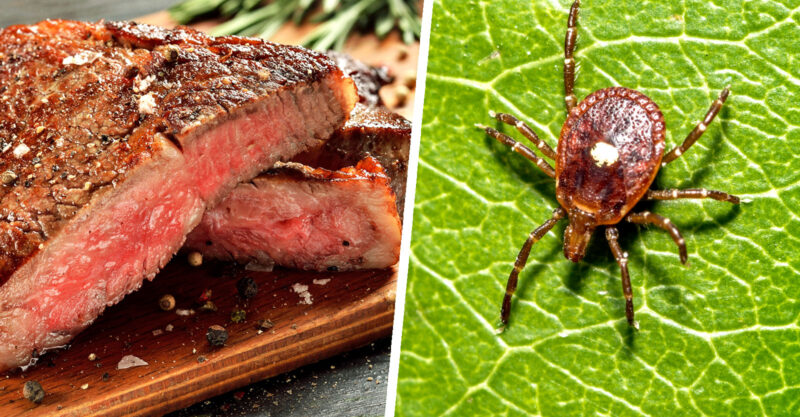Miss a day, miss a lot. Subscribe to The Defender's Top News of the Day. It's free.
Editor’s note: This is part 3 (read part 1 and part 2) of a three-part series on red meat allergy, a serious, lifestyle-limiting disorder that causes individuals to experience mild- to life-threatening allergic symptoms several hours after eating red meat. Also known as alpha-gal syndrome (AGS), meat allergy has no cure — the only “treatment” is to avoid certain meats and animal products.
Most popular articles on meat allergy identify the culprit as alpha-gal, a sugar, but this is misleading. Even popular health-oriented websites and peer-reviewed papers do this.
However, the alpha-gal sugar by itself does not cause AGS. The culprit is specific proteins in tick saliva attached to alpha-gal. Since none of the four “ingredients of concern” discussed in part 2 — gelatin, albumin, glycerin, and stearate — contain tick proteins, they cannot induce AGS.
More than 35 studies conducted in 19 countries have established the tick-AGS connection.
Additional studies strengthen the AGS-tick-protein connection. A 2015 Japanese paper reported that 24 of 30 patients with red meat allergies were sensitized to a specific alpha-gal-linked protein in tick saliva.
Similar alpha-gal-linked proteins were found in tick species known to transmit alpha-gal, but not in others.
Two drugs mentioned in part 1, heparin (a blood thinner) and cetuximab (a cancer drug), may cause serious reactions in individuals with AGS but these episodes are similar to reactions after eating meat: they are a manifestation of AGS, not the cause. If they caused AGS this effect would be widespread among people taking these drugs, and would certainly have been noticed decades ago.
We also noted in parts 1 and 2 the special case of gelatin, a common ingredient in drugs and vaccines, which also causes allergic reactions in individuals with AGS. Since the alpha-gal sugar can only cause AGS when it is attached to specific tick proteins, gelatin by itself is highly unlikely to cause the illness.
If gelatin in injected drugs caused meat allergy someone would have noticed decades before 2009, when AGS was first described.
Another clue that alpha-gal protein, and not sugar, causes AGS is the unusual hours-long delay in symptomatology after eating meat. In contrast, allergies to common foods usually occur within minutes of exposure.
According to one hypothesis, alpha-gal attached to fats, as opposed (or in addition) to proteins, may be responsible for the delayed allergic response because fats take longer to digest than proteins.
Another possible explanation for the delay is the time required to digest meat, remove alpha-gal, and attach it to another molecule that can carry it into and through the bloodstream.
Some evidence suggests that after digestion and release, alpha-gal enters the bloodstream either directly attached to or surrounded by fats.
How about injectable drugs, like vaccines?
We also know from parts 1 and 2 that many vaccines contain alpha-gal, so connecting AGS to vaccines seems reasonable.
But if vaccination caused AGS the association would have been apparent decades ago.
Meat allergy is still extremely rare, with only around 110,000 “suspected cases” reported in the U.S. in the 13 years between 2010 and 2022. This calculates to fewer than 8,000 cases per year, or an incidence of about 2.5 cases per 100,000 people per year (based on the average U.S. population of 310 million during that time period).
During those same 13 years, Americans received more than a billion vaccine doses, including 667 million COVID-19 shots.
There are approximately 50 million U.S. children ages 12 and under. The Centers for Disease Control and Prevention (CDC) vaccination schedule lists 29 different injections through age 6 (excluding COVID and flu), and compliance is between 80% and 90% for the various shots.
This means U.S. children in that age group have already received more than 1.2 billion vaccine doses.
About half the U.S. population receives a flu shot annually. Over those 13 years, Americans received more than 1.86 billion flu shots.
Adding up all the doses (and for now ignoring all other vaccinations) and dividing by 12 years, we see that every year Americans receive, on average, 311 million doses of vaccines but experience just 8,000 cases of meat allergy.
That comes out to 1 case of meat allergy for every 39,000 shots.
Also, note that the four “ingredients of concern” have been used in oral and injected medicines for decades, but meat allergy has been known only since 2009. If exposure to gelatin, albumin, stearate and glycerin caused meat allergies to any significant degree this would surely have been noticed before 2009.
Finally, all biotech therapies at some point use products from cows to sustain the engineered cells that express these products. Although many processes have switched to animal-derived component-free cell culture media, 64% of current biomanufacturing processes still use “classical media,” which include bovine-derived ingredients.
Recombinant protein treatments have been used since the mid-1980s, and virtually all are injected or infused, typically at very high doses.
If injected cow-derived vaccine ingredients caused meat allergies they would have been identified and confirmed long before 2009.
This is not to vouch for the safety of vaccines generally but to emphasize that avoiding vaccines will not protect you from meat allergies.
One could also argue that, like the “four ingredients of concern” in vaccines and other injected drugs, tick species that transmit AGS have also been around for eons. If they were the sole cause of meat allergy someone should have noticed before 2009.
The same could be said for Lyme disease, which was first described in the medical literature in 1975 after a cluster of cases emerged around Lyme, Connecticut. The infectious Lyme agent, a bacterium, was only identified in 1981.
But according to genetic studies that microbe — the Lyme spirochete — has been around for at least 60,000 years. A sharp rise in the deer population, particularly in the northeastern U.S., has increased the natural host population for Lyme-carrying ticks. At the same time deforestation has brought people and deer — and the ticks they carry — closer together.
These factors might also explain the mysterious emergence of AGS in 2009 although ticks have been plaguing humans since Biblical times.
What if you’re not in ‘lone star territory’?
The lone star tick is found primarily in about 30 U.S. states within a geographic region bounded by Maine at its northeast corner, Florida (southeast), Texas (southwest) and Missouri (northwest).
This creature shares its extensive habitat with about half the U.S. population, as shown in Figure 1:

But AGS is a worldwide problem and in every instance, an endemic tick is the culprit.
Separate alpha-gal-carrying tick species have been found in Japan, Sweden and Australia. In the U.S., at least four tick species other than the lone star tick have been implicated.
A 2019 study confirmed three of these and added a fifth species to the suspect list.
So tick bites generally, and not the lone star tick, in particular, appear to be responsible for alpha-gal sensitization.
The message to people who enjoy the outdoors is simple: living outside the lone star tick habitat provides no guarantee against contracting AGS as this allergy is found all over the U.S.
What do antibodies tell us?
AGS diagnosis relies on patient history, skin tests, oral food or drug challenges and the presence of immunoglobin E (IgE) antibodies, which are mainly involved in allergic responses. But 30+% of Americans already carry AGS-specific IgEs and only a tiny fraction become allergic — so the IgE test provides very little actionable information.
All humans also carry IgG, IgM and IgA antibodies to alpha-gal-linked proteins. These antibodies make up about 1% of all the antibodies carried by humans.
These antibodies normally provide immunological defense against pathogens and “foreign” chemicals entering the body. Their presence signifies exposure to alpha-gal proteins but carries no clinical significance in terms of AGS.
It appears, then, that the presence of IgE antibodies to alpha-gal proteins is a hallmark of AGS and necessary for developing meat allergy, but by itself is insufficient to cause AGS.
The only difference between merely carrying antibodies and getting sick is a tick bite.
And therein lies the main mystery behind AGS: What is the biological switch that causes allergy in sensitized individuals, and how is it activated? What factors in tick saliva cause previously asymptomatic antibody carriers to get seriously ill?
Scientists believe that activation of basophils, a type of immune cell involved in allergy, initiates this process. Basophils release histamine, a well-known mediator of allergic reactions.
Independent of IgE status, evidence of basophil recruitment and activation very nearly confirms that someone has AGS and not merely antibodies, according to a 2019 paper.
The authors concluded:
“The basophil activation test should be considered as an additional diagnostic test before performing time-consuming and potentially risky oral provocation tests. The [test endpoints] were the best parameters for distinguishing patients with alpha-gal syndrome from subjects with asymptomatic alpha-gal sensitization.”
Conclusion
People who enjoy red meat are understandably concerned about an AGS diagnosis. Vegetarianism is not for everyone, and the potential presence of minute quantities of allergy triggers in non-meat foods can also be a source of ongoing anxiety.
Examination of the available evidence on how people develop AGS leads to conclusions that may surprise some readers:
- The main culprit in sensitization and allergy is not the free, unbound alpha-gal sugar but alpha-gal attached to specific tick proteins.
- Until further evidence is found: no tick, no AGS.
- People with AGS may also experience severe reactions to products containing the “four ingredients of concern,” but these reactions are a consequence, not a cause, of AGS.
- Many vaccines contain alpha-gal according to the CDC but it is unclear whether this is the free alpha-gal sugar or alpha-gal attached to proteins (most likely from cows). Regardless, the attached proteins are not from ticks so, according to the current paradigm, they cannot cause AGS.
- Most news reports implicate the lone star tick to the exclusion of other tick species, which may lead to a false sense of security for individuals who live outside that species’ natural habitat. The safest course is to avoid encounters with ticks whenever possible.
- Sensitization, as determined by a test for alpha-gal IgE antibodies, only rarely means a person will develop AGS. The overwhelming majority of people with IgA, IgE, IgG and IgM antibodies to alpha-gal will never develop a food allergy.
- A basophil activation test can confirm AGS in individuals with alpha-gal antibodies whose response to eating meat is mild or sporadic.










